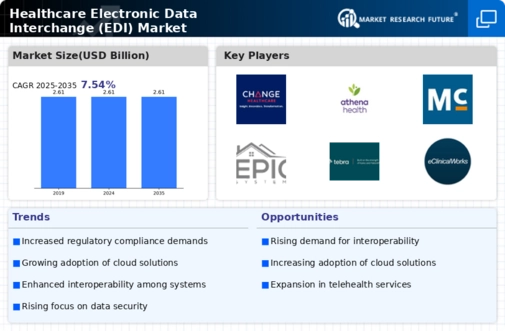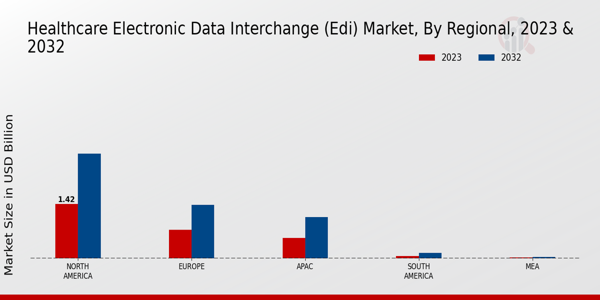Advancements in Technology
Technological advancements significantly influence the Global Healthcare Electronic Data Interchange (EDI) Market Industry. Innovations such as cloud computing, artificial intelligence, and blockchain are transforming how healthcare data is exchanged and managed. These technologies enhance the security, speed, and accuracy of EDI transactions, making them more appealing to healthcare organizations. For instance, cloud-based EDI solutions offer scalability and flexibility, allowing organizations to adapt to changing needs. As technology continues to evolve, the market is expected to benefit from increased adoption of advanced EDI systems, further solidifying its position in the healthcare landscape.
Market Growth Visualization
Rise of Telehealth Services
The rise of telehealth services is reshaping the Global Healthcare Electronic Data Interchange (EDI) Market Industry. As healthcare delivery models evolve, the integration of telehealth necessitates efficient data exchange between providers and patients. EDI solutions facilitate the secure transmission of patient information, appointment scheduling, and billing processes in telehealth settings. This trend is particularly relevant in remote patient monitoring and virtual consultations, where timely data exchange is critical. The growing acceptance of telehealth is likely to drive the demand for EDI systems, as healthcare organizations seek to enhance patient engagement and streamline operations in this expanding sector.
Cost Reduction and Efficiency
Cost reduction remains a pivotal driver in the Global Healthcare Electronic Data Interchange (EDI) Market Industry. By automating data exchange processes, healthcare organizations can significantly lower administrative costs associated with manual data entry and processing. EDI solutions streamline billing, claims processing, and patient record management, resulting in enhanced operational efficiency. This efficiency translates into reduced overhead costs and improved cash flow for healthcare providers. As organizations increasingly recognize the financial benefits of adopting EDI systems, the market is poised for sustained growth, with a projected CAGR of 0.0% from 2025 to 2035, maintaining a market value of 2.61 USD Billion.
Regulatory Compliance and Standards
Regulatory compliance plays a crucial role in shaping the Global Healthcare Electronic Data Interchange (EDI) Market Industry. Governments and regulatory bodies worldwide are implementing stringent standards to ensure data security and privacy in healthcare transactions. Compliance with regulations such as HIPAA in the United States and GDPR in Europe necessitates the adoption of secure EDI solutions. As organizations strive to meet these requirements, the demand for EDI systems that facilitate compliant data exchange is likely to increase. This regulatory landscape not only fosters trust among stakeholders but also propels the growth of the EDI market, which is expected to maintain a steady value of 2.61 USD Billion by 2035.
Increased Demand for Interoperability
The Global Healthcare Electronic Data Interchange (EDI) Market Industry experiences heightened demand for interoperability among healthcare systems. As healthcare providers increasingly seek to streamline operations and enhance patient care, the need for seamless data exchange becomes paramount. Interoperability facilitates the integration of various healthcare applications, enabling efficient communication between providers, payers, and patients. This trend is reflected in the projected market value of 2.61 USD Billion in 2024, indicating a robust growth trajectory. The emphasis on interoperability not only improves operational efficiency but also enhances patient outcomes, thereby driving the adoption of EDI solutions across the globe.





















